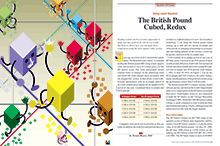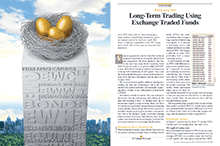LETTERS TO THE EDITOR
March 2013 Letters To The Editor
The editors of S&C invite readers to submit their opinions
and information on subjects relating to technical analysis and this magazine.
This column is our means of communication with our readers. Is there something
you would like to know more (or less) about? Tell us about it. Without a source
of new ideas and subjects coming from our readers, this magazine would not
exist.
Address your correspondence to: Editor, Stocks & Commodities,
4757 California Ave. SW, Seattle, WA 98116-4499, or E-mail to editor@traders.com.
All letters become the property of Technical Analysis, Inc. Letter-writers
must include their full name and address for verification. Letters may
be edited for length or clarity. The opinions expressed in this column do not
necessarily represent those of the magazine. —Editor
TWO EXCELLENT ARTICLES
 Editor,
Editor,
Dennis Meyers deserves huge congratulations on his January 2013 article in S&C, “The British Pound Cubed, Redux.” I think it’s one of the best articles ever published in Stocks & Commodities. The article includes numerous solid techniques based on Meyers’s considerable experience. It offered clear and detailed formulas, and it had meaningful length. I wish all articles provided as sufficient information to reproduce the results as Meyers’s did.
Congratulations also to Dirk Vandycke for his excellent article in the January 2013 issue of S&C, “The Chartmill Value Indicator.” It’s very well written and insightful. I especially appreciate how he included detailed formulas so we can reproduce his calculations. I only wish I didn’t have to wait another month to see the continuation of this article. Please write much more.
Scott Z.
INTERVIEW WITH MISH SCHNEIDER
 Editor,
Editor,
Thanks so much for your interview with Mish Schneider in your November 2012 issue (“Michele ‘Mish’ Schneider Of MarketGauge”). It was one of the most encouraging articles for a trader one could read. It really reinforced what you teach. It was really neat to get the glimpse into how she got to where she is today. Sure glad Keith was there to rescue her from the “floor wolves.”
Thanks for that interview and thanks to her for all she does to help the retail trader.
Steve P.
DMI CLUSTERS
Editor,
I have been reading with interest BC Low’s article “Identify The Start Of A Trend With DMI” in the November 2012 issue of Stocks & Commodities, and I have a question I hope he would help me with. I am confused on how many periods to use for the three ADX lines and the +DI and -DI clusters.
The text of the article states that the three ADX lines are based on three, four, and five periods. The text also states that the +DI and -DI clusters are based on five, eight, and 14 periods. However, the charts that are included with the article do not seem to match these numbers.
For example, the ADX plot in Figure 2 shows 70, 50, and 58 periods. The ADX plot in Figure 3 shows 31, 26, and 28 periods. The ADX plot in Figure 4 shows 64, 40, and 51 periods. The +DI plot in Figure 5 shows 41, 39, and 35 periods, and the ADX plot shows 53, 59, and 61 periods. In addition, the -DI plot in Figure 6 shows 15, 12, and eight periods, and the ADX plot shows 71, 43, and 56 periods.
I would very much appreciate any help you would provide on this to help me understand.
Geoff Clark
Author BC Low replies:
 To explain for a minute about the basics of technical analysis for anyone reading this who may not be familiar, indicators tend to be derived from formulas, such as the ever-popular moving average (MA). But the number of periods used in a moving average can vary from trader to trader. Some prefer smaller moving average windows, such as a five-period MA, while others use a medium-size value, for example, a 30-period MA. Whichever parameter is used, five or 30, a value for the MA is calculated and plotted.
To explain for a minute about the basics of technical analysis for anyone reading this who may not be familiar, indicators tend to be derived from formulas, such as the ever-popular moving average (MA). But the number of periods used in a moving average can vary from trader to trader. Some prefer smaller moving average windows, such as a five-period MA, while others use a medium-size value, for example, a 30-period MA. Whichever parameter is used, five or 30, a value for the MA is calculated and plotted.
For all three clusters, the numbers I recommended were tested and chosen to produce the intended signals. Thus, the parameter sets 3,4,5 and 5,8,14 were picked to produce those signals, and we don’t change them if we are satisfied with them. Useful signals are triggered when the ADX, +DI, and -DI lines reach 70 to 90, or below 20. So we monitor the levels to look for these signals.
I hope this explains. I also hope you will find the signals useful. I recently used them for some very successful trades.
KONDRATIEFF WAVE PROJECTIONS
Editor,
I was going through my files and came upon Koos van der Merwe’s April 2011 S&C article (“Today’s K-Wave And Beyond”), which I found very interesting and informative. I wondered if he had updated or revisited the article since he wrote it?
Parker Sroufe
You are in luck; author Koos van der Merwe has just revisited his July 2012 S&C article “The Kondratieff Wave And The Presidential Cycle.” Look for his new article on the subject in an upcoming issue.—Editor
METASTOCK CODE FOR HACO
 Editor,
Editor,
I was scanning through my copy of the July 2012 issue and saw that my hero, Sylvain Vervoort, wrote an article (“Long-Term Trading Using Exchange Traded Funds”) on HACO (heikin-ashi candles oscillator) that I had completely missed.
Is it possible to find the Traders’ Tips code for that issue at your website? I am a MetaStock user.
Bill
MetaStock did not provide code for Traders’ Tips that month since Vervoort’s article already included it. You will find that MetaStock code by Vervoort in the Article Code area of our website here:
https://technical.traders.com/sub/Codes/2012/072012Vervoort.asp
Code for other software based on Vervoort’s July 2012 article can be found in the Traders’ Tips area of our site at www.traders.com.—Editor
Originally published in the March 2013 issue of Technical Analysis of Stocks & Commodities magazine. All rights reserved. © Copyright 2013, Technical Analysis, Inc.
Return to
Contents
 Editor,
Editor, Editor,
Editor, To explain for a minute about the basics of technical analysis for anyone reading this who may not be familiar, indicators tend to be derived from formulas, such as the ever-popular moving average (MA). But the number of periods used in a moving average can vary from trader to trader. Some prefer smaller moving average windows, such as a five-period MA, while others use a medium-size value, for example, a 30-period MA. Whichever parameter is used, five or 30, a value for the MA is calculated and plotted.
To explain for a minute about the basics of technical analysis for anyone reading this who may not be familiar, indicators tend to be derived from formulas, such as the ever-popular moving average (MA). But the number of periods used in a moving average can vary from trader to trader. Some prefer smaller moving average windows, such as a five-period MA, while others use a medium-size value, for example, a 30-period MA. Whichever parameter is used, five or 30, a value for the MA is calculated and plotted. Editor,
Editor,